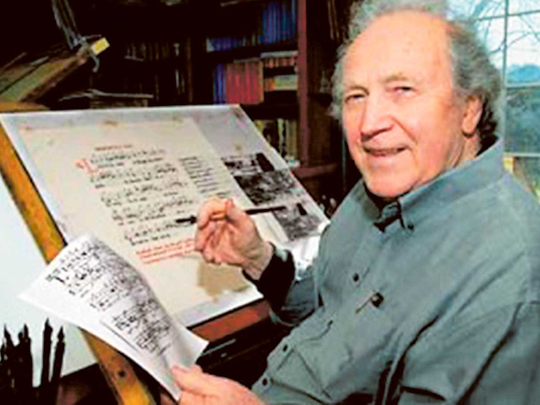
Because of a Trappist monk, Apple computer displays look the way they do today.
The monk was the Rev. Robert Palladino, who died February 26 at 83. A Roman Catholic priest who began his vocation in a monastic order, Palladino was also a world-renowned master of calligraphy.
“Priest and calligrapher,” his business card read, in his unimpeachable Renaissance italic, and he long plied both trades at once. For years, babies he baptised received baptismal certificates in his flawless hand. In Oregon, where he made his home, Palladino hand-lettered the state medical licenses for generations of newly minted doctors.
As a Trappist brother, Palladino learnt his art in silence, honed it over years of study and eventually, on leaving his order, taught it to others.
To his students, he brought a world of genteel scholarship and quiet contemplation; a world whose modus operandi — by hand, with ink, on paper, parchment and vellum — was little changed for centuries; a world of classical music (an accomplished singer, he liked to ply his calligraphy to Beethoven), Gregorian chant and the Latin Mass, which he continued celebrating in discreet defiance long after Vatican II.
Into that world burst a young college dropout named Steve Jobs.
It is a coincidence no less exquisite than Palladino’s finest calligraphy that “Silicon Valley’s future most famous screamer studied with a monk who spent years taking a vow of silence,” as The Hollywood Reporter wrote shortly after Jobs’ death in 2011.
A character based on Palladino, played by strapping young actor William Mapother, appears in ‘Jobs’, the 2013 Hollywood film starring Ashton Kutcher. To reporters who asked Palladino whether he planned to see the film, he replied, characteristically, that he saw few movies of any kind.
An authority on the history, structure and aesthetics of scripts from antiquity to the present, Palladino taught calligraphy at Reed College in Portland, Oregon, from 1969 until his retirement, in 1984.
The college’s calligraphy programme, which flourished from 1938 until Palladino’s retirement, was widely regarded as the foremost in the country, training many respected artists, typographers and graphic designers. For decades, nearly every sign and poster on campus was the graceful fruit of its labour.
Jobs briefly attended Reed in 1972 before dropping out for economic reasons, but hung around campus for more than a year afterward; during that time, he audited Palladino’s class. After helping to found Apple in 1976, he often credited the company’s elegant on-screen fonts — and his larger interest in the design of computers as physical objects — to what he had been taught there.
“I learnt about serif and sans serif typefaces, about varying the amount of space between different letter combinations, about what makes great typography great,” Jobs said in a 2005 commencement address at Stanford. “It was beautiful, historical, artistically subtle in a way that science can’t capture, and I found it fascinating.” He continued:
“Ten years later, when we were designing the first Macintosh computer, it all came back to me. And we designed it all into the Mac. It was the first computer with beautiful typography. If I had never dropped in on that single course in college, the Mac would have never had multiple typefaces or proportionally spaced fonts. And since Windows just copied the Mac, it’s likely that no personal computer would have them.”
Asked about his famous charge in a 2013 interview with The Catholic Sentinel, an Oregon publication, Palladino recalled, “He was most pleasant.”
The word “calligraphy” is born of the classical Greek “kallos” (“beautiful”) and “grapho” (“write”). In Palladino’s hands, however, calligraphy was about far more than mere beautiful letters: It was about the ways those letters can be coaxed to nestle companionably together to make words, and how those words in turn can be assembled to form a meaningful text.
Whether he was writing in the Phoenician alphabet, the Hebrew, the Greek or the Roman — encompassing myriad forms, including the elegant square capitals cut into Roman monuments or the curvaceous uncial script used by early medieval scribes — every stroke of Palladino’s pen entailed meditative deliberation, historical fealty and not a single wasted movement.
The work was, for him, the logical culmination of a fascination with the art of the written word that had begun in boyhood.
Robert Joseph Palladino was born in Albuquerque, New Mexico, on November 5, 1932. His paternal grandfather, Gaetano Palladino, was an Italian stonemason and architect who settled in New Mexico after he was engaged to build the St. Francis Cathedral in Santa Fe.
The youngest of eight children, Palladino had the opportunity to observe the handwriting of seven siblings before him, and he saw that it was good. He grew fascinated, he later said, by the sublime marriage of form and function that writing embodied, especially when it came to communicating the word of God.
In 1950, at 17, he joined a Trappist order in Pecos, New Mexico. He received his early calligraphic training under the monastery’s scribe.
In 1955, after years of farming the unforthcoming New Mexico soil, the monastery moved to the Willamette Valley in Oregon. There, besides tending its orchards, Palladino served as the monastery’s choirmaster, ran its book bindery and became its principal scribe.
“In a silent monastery, signs do come in handy,” he told The Catholic Sentinel in 2011.
He was ordained a priest in 1958. But the reforms of Vatican II (1962-65) — including the dissolution of monastic silence, the supplanting of Gregorian chant by vernacular music and the replacement of Latin by modern languages — discomforted him, and in 1968 he left the monastery.
“You cannot like that way of life unless you are completely enamoured of it,” Palladino, recalling his Trappist days, said in an unpublished memoir, written — unsurprisingly — entirely by hand. “When it changed, I could no longer dedicate myself to it. It no longer satisfied my longing for union with God.”
Settling in Portland, he joined the Reed faculty the next year. In 1969 he travelled to Davenport, Iowa, for advanced study in calligraphy, stonecutting, art history, brush writing and lettering at St. Ambrose College, where he was a student of the Rev. Edward Catich, an eminent calligrapher and paleographer.
Dispensed from his priestly vows by Pope Paul VI, Palladino married Catherine Halverson, the principal clarinettist of the Portland Symphony, in 1969.
Their son, Eric, is his only immediate survivor. Palladino’s death, at his home in Sandy, Oregon, was announced by Reed College.
Catherine Palladino died in 1987. In 1995 Palladino was readmitted to the priesthood, serving in Oregon parishes. He also taught calligraphy at Portland State University, the Pacific Northwest College of Art and elsewhere.
Though Palladino demonstrably influenced Jobs, the converse cannot be said. To the end of his life, Palladino never owned, or even once used, a computer.
“I have my hand,” he would say, “and I have my pen. That’s it.”












